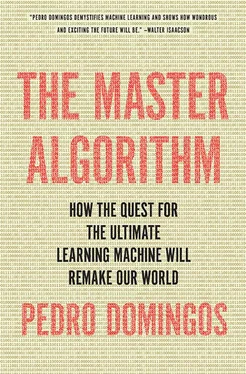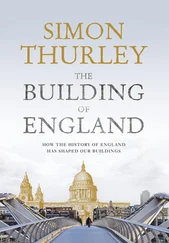In my PhD thesis, I designed an algorithm that unifies instance-based and rule-based learning in this way. A rule doesn’t just match entities that satisfy all its preconditions; it matches any entity that’s more similar to it than to any other rule, in the sense that it comes closer to satisfying its conditions. For instance, someone with a cholesterol level of 220 mg/dL comes closer than someone with 200 mg/dL to matching the rule If your cholesterol is above 240 mg/dL, you’re at risk of a heart attack . RISE, as I called the algorithm, learns by starting with each training example as a rule and then gradually generalizing each rule to absorb the nearest examples. The end result is usually a combination of very general rules, which between them match most examples, with more specific rules that match exceptions to those, and so on all the way to a “long tail” of specific memories. RISE made better predictions than the best rule-based and instance-based learners of the time, and my experiments showed that this was precisely because it combined the best features of both. Rules can be matched analogically, and so they’re no longer brittle. Instances can select different features in different regions of space and so combat the curse of dimensionality much better than nearest-neighbor, which can only select the same features everywhere.
RISE was a step toward the Master Algorithm because it combined symbolic and analogical learning. It was only a small step, however, because it doesn’t have the full power of either of those paradigms, and it’s still missing the other three. RISE’s rules can’t be chained together in different ways; each rule just predicts the class of an example directly from its attributes. Also, the rules can’t talk about more than one entity at a time; for example, RISE can’t express a rule like If A has the flu and B was in contact with A, B may have the flu as well . On the analogical side, RISE just generalizes the simple nearest-neighbor algorithm; it can’t learn across domains using structure mapping or some such strategy. At the time I finished my PhD, I didn’t see a way to bring together in one algorithm the full power of all the five paradigms, and I set the problem aside for a while. But as I applied machine learning to problems like word-of-mouth marketing, data integration, programming by example, and website personalization, I kept seeing how each of the paradigms provided only part of the solution. There had to be a better way.
And so we have traveled through the territories of the five tribes, gathering their insights, negotiating the border crossings, wondering how the pieces might fit together. We know immensely more now than when we started out. But something is still missing. There’s a gaping hole in the center of the puzzle, making it hard to see the pattern. The problem is that all the learners we’ve seen so far need a teacher to tell them the right answer. They can’t learn to distinguish tumor cells from healthy ones unless someone labels them “tumor” or “healthy.” But humans can learn without a teacher; they do it from the day they’re born. Like Frodo at the gates of Mordor, our long journey will have been in vain if we don’t find a way around this barrier. But there is a path past the ramparts and the guards, and the prize is near. Follow me…
CHAPTER EIGHT: Learning Without a Teacher
If you’re a parent, the entire mystery of learning unfolds before your eyes in the first three years of your child’s life. A newborn baby can’t talk, walk, recognize objects, or even understand that a object continues to exist when the baby isn’t looking at it. But month after month, in steps large and small, by trial and error and great conceptual leaps, the child figures out how the world works, how people behave, and how to communicate. By a child’s third birthday, all this learning has coalesced into a stable self, a stream of consciousness that will continue throughout life. Older children and adults can time-travel, aka remember things past, but only so far back. If we could revisit ourselves as infants and toddlers and see the world again through those newborn eyes, much of what puzzles us about learning-even about existence itself-would suddenly seem obvious. But as it is, the greatest mystery in the universe is not how it begins or ends, or what infinitesimal threads it’s woven from, it’s what goes on in a small child’s mind: how a pound of gray jelly can grow into the seat of consciousness.
The scientific study of children’s learning is still young, having begun in earnest only a few decades ago, but it has already come remarkably far. Infants can’t answer questionnaires or follow experimental protocols, but we can infer a surprising amount about what goes on in their minds by videotaping and studying their reactions during experiments. A coherent picture emerges: an infant’s mind isn’t just the unfolding of a predefined genetic program or a biological device for recording correlations in sense data; rather, the infant’s mind actively synthesizes his or her reality, and this reality changes quite radically over time.
Increasingly, and most relevant to us, cognitive scientists express their theories of children’s learning in the form of algorithms. Many machine-learning researchers take inspiration from this. Everything we need is right there in a child’s mind, if only we can somehow capture its essence in computer code. Some researchers even argue that the way to create intelligent machines is to build a robot baby and let him experience the world as a human baby does. We, the researchers, would be his parents (perhaps even with an assist from crowdsourcing, giving a whole new meaning to the term global village ). Little Robby-let’s call him that, in honor of the chubby but much taller robot in Forbidden Planet -is the only robot baby we’ll ever have to build. Once he has learned everything a three-year-old knows, the AI problem is solved. We can copy the contents of his mind into as many other robots as we like, and they’ll take it from there, the hardest part already accomplished.
The question, of course, is what algorithm should be running in Robby’s brain at birth. Researchers influenced by child psychology look askance at neural networks because the microscopic workings of a neuron seem a million miles from the sophistication of even a child’s most basic behaviors, like reaching for an object, grasping it, and inspecting it with wide, curious eyes. We need to model the child’s learning at a higher level of abstraction, lest we miss the planet for the trees. Above all, even though children certainly get plenty of help from their parents, they learn mostly on their own, without supervision, and that’s what seems most miraculous. None of the algorithms we’ve seen so far can do it, but we’re about to see several that can-bringing us one step closer to the Master Algorithm.
Putting together birds of a feather
We flip the “on” switch, and Robby’s video eyes open for the very first time. At once he’s flooded with what William James memorably called the “blooming, buzzing confusion” of the world. With new images streaming in at a rate of dozens per second, one of the first things he must do is learn to organize them into larger chunks. The real world is made up of objects that persist over time, not random pixels changing arbitrarily from one moment to the next. Mommy isn’t replaced by a smaller Mommy when she walks away. Putting a dish on the table doesn’t make a white hole in it. A young baby is not surprised if a teddy bear passes behind a screen and reemerges as an airplane, but a one-year-old is. Somehow, he’s figured out that teddy bears are different from airplanes and don’t spontaneously transmute. Soon afterward, he’ll figure out that some objects are more alike than others and start forming categories. Given a pile of toy horses and pencils to play with, a nine-month-old doesn’t think to sort them into separate piles of horses and pencils, but an eighteen-month-old does.
Читать дальше












